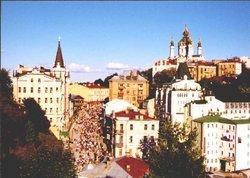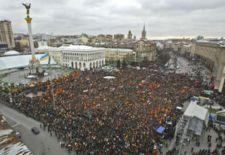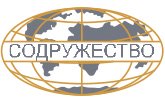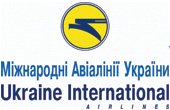Kyiv, an Ancient and Eternally Young City
 ‘The cradle of
the East Slavic civilization’, ‘mother of all Russian cities’, ‘majestic and
golden-domed’, ‘a city of parks’ – all these are the epithets given to the more
than one-and-a-half thousand years-old Kyiv.“ It was founded at the end of the V century AD by the legendary East
Slavic tribe leader Kyi (and the city is named after him, translated as
‘belonging to Kyi’), his brothers Schek and Khoriv, and also their sister
Lybid. At first, Kyiv was a fortress city located on the bank
of the Dnipro River at the intersection of trade routes of Greeks and Varangians
(Vikings).Soon, Kyiv became the first capital of the Kievan
Rus’, first Ukrainian state (end of the IX century–1240). The city flourished
in times of Grand Prince Yaroslav the Wise (1010–1054) who became relative of
royal families in France, Norway, Hungary, and Poland. In the XI century Kyiv
was the largest city in Europe: at the beginning of that century the
present-day capital of Ukraine had population of 50 thousand. For comparison:
at that time London has only 20 thousand inhabitants. XI century German
chronicler Adam of Bremen called Kyiv a rival of Constantinople.Since those legendary times and for almost one
thousand years Kyiv’s skyline is adorned by domes of the Kyiv-Pechersk Lavra
and St. Sophia Cathedral, both UNESCO World Heritage Sites.Between 30 January 1918 and December 1919 Kyiv was the capital of the
Ukrainian People’s Republic, and between June 1934 and 1991 – the capital of
the Ukrainian Soviet Socialist Republic. On 24 August 1991 when Ukraine finally
gained independence, Kyiv became the capital of the sovereign state Ukraine.
That day marked the beginning of a new era in the city’s history. Kyiv’s main
square, Maidan Nezalezhnosti (Independence Square) has changed its appearance
and now pleases the eye of Kievites and visitors alike. Kyiv experiences a real
construction boom: new office and retail centres are popping up all over the
city. Now even those who last visited Kyiv some 10–15 years ago may not even
recognize it. Various festivals, contests, fairs, arts and crafts exhibitions –
all this proves the flourishing business and cultural life of the city, and the
visitors to Kyiv will feel at the same time the aura of bygone times and the
pulse of modern life
‘The cradle of
the East Slavic civilization’, ‘mother of all Russian cities’, ‘majestic and
golden-domed’, ‘a city of parks’ – all these are the epithets given to the more
than one-and-a-half thousand years-old Kyiv.“ It was founded at the end of the V century AD by the legendary East
Slavic tribe leader Kyi (and the city is named after him, translated as
‘belonging to Kyi’), his brothers Schek and Khoriv, and also their sister
Lybid. At first, Kyiv was a fortress city located on the bank
of the Dnipro River at the intersection of trade routes of Greeks and Varangians
(Vikings).Soon, Kyiv became the first capital of the Kievan
Rus’, first Ukrainian state (end of the IX century–1240). The city flourished
in times of Grand Prince Yaroslav the Wise (1010–1054) who became relative of
royal families in France, Norway, Hungary, and Poland. In the XI century Kyiv
was the largest city in Europe: at the beginning of that century the
present-day capital of Ukraine had population of 50 thousand. For comparison:
at that time London has only 20 thousand inhabitants. XI century German
chronicler Adam of Bremen called Kyiv a rival of Constantinople.Since those legendary times and for almost one
thousand years Kyiv’s skyline is adorned by domes of the Kyiv-Pechersk Lavra
and St. Sophia Cathedral, both UNESCO World Heritage Sites.Between 30 January 1918 and December 1919 Kyiv was the capital of the
Ukrainian People’s Republic, and between June 1934 and 1991 – the capital of
the Ukrainian Soviet Socialist Republic. On 24 August 1991 when Ukraine finally
gained independence, Kyiv became the capital of the sovereign state Ukraine.
That day marked the beginning of a new era in the city’s history. Kyiv’s main
square, Maidan Nezalezhnosti (Independence Square) has changed its appearance
and now pleases the eye of Kievites and visitors alike. Kyiv experiences a real
construction boom: new office and retail centres are popping up all over the
city. Now even those who last visited Kyiv some 10–15 years ago may not even
recognize it. Various festivals, contests, fairs, arts and crafts exhibitions –
all this proves the flourishing business and cultural life of the city, and the
visitors to Kyiv will feel at the same time the aura of bygone times and the
pulse of modern life
Kyiv: Top 5 Tourist Attractions
1. Kyiv-Pechersk Lavra

The Kyiv-Pechersk Lavra is a unique Orthodox Christian monastery inscribed as UNESCO World Heritage Site. It was founded in 1051 by Greek Orthodox monks Anthony and Theodosius in caves near the summer residence of Grand Prince of Kyiv. In the eleventh century the monastery became the centre for spreading and establishing Christianity in the Kievan Rus’. In the XII century the monastery received the status of ‘lavra’, i.e. the main monastery.
In its time the Kyiv-Pechersk Lavra played an important role in development of the ancient Rus’ culture by being the centre of chronicle writing. Works of foreign authors were translated into the Old Church Slavonic language and rewritten. Famous chroniclers Nestor (author of the Primary Chronicle), Nikon, Sylvester worked in the Lavra. The Kiev-Pechersk Patericon, an important source of Kyiv’s history was written in the XIII century.The Kyiv-Pechersk Lavra contains numerous architectural monuments built since the XI century: the Dormition Cathedral, the Gate Church of the Trinity, fortress walls with arrow loops and towers (1698–1701), the Great Lavra Belltower (1731–1744) 96.52 meters high.
Many famous people are buried inside the Lavra including Prince Yuri Dolgoruki, the founder of Moscow.
Over 30 museums and galleries opened in Kiev-Pechersk Lavra display manuscripts of old printed books, drapery and embroidery collections. The Museum of Historical Treasures with its famous Gold Pectoral, ancient engravings and works of modern artists, and in particular, a unique collection of microminiatures will surely excite a special interest.
2. St. Sophia Cathedral
 An astounding feeling
captures everybody who crosses the threshold of the glorious Sophia of Kiev.
The noisy present is left somewhere behind the walls, the ages give way, and
the ancient past appears.
An astounding feeling
captures everybody who crosses the threshold of the glorious Sophia of Kiev.
The noisy present is left somewhere behind the walls, the ages give way, and
the ancient past appears.
The St. Sophia Cathedral is a world-famous XI century architectural and monumental painting landmark inscribed as UNESCO World Heritage Site and protected by this international organization.
Ancient chronicles mention foundation dates of the cathedral to be both 1017 and 1037. The cathedral’s name is derived from the Greek word Sophia meaning wisdom. The chroniclers call Grand Prince of Kiev Yaroslav the Wise the founder of the St. Sophia Cathedral who finished what his father Volodymyr had started and Christianized the Kievan Rus’.
For centuries the Sophia of Kiev was the main sanctuary of Rus-Ukraine: the ‘Rus’ archdiocese’. As the main cathedral of the state, the Sophia of Kiev was the spiritual, political, and cultural centre. Ceremonial ‘ascension’ to the throne of Grand Prince, ecumenical councils, reception of ambassadors, ratification of political treaties took place under the vault of the St. Sophia. Chronicles were kept by the cathedral monks, and the first library and school known in the Rus’ were established under the auspices of the cathedral. For many centuries the Sophia of Kiev was and still is a witness and direct participant of Kyiv’s life
3. National Museum of the History of the Great Patriotic War of 1941–1945

The Memorial Complex created on the base of museum of history of the Great Patriotic War of 1941–1945 was opened on 9 May 1981 on picturesque hills of the Dnipro River. The Memorial combined several monuments, the central of which is the monumental sculpture of the Motherland (which stands 62 m tall with the overall structure measuring 102 m). At the base of the pedestal is the museum.
The third, modern exposition was opened in 1994–1995 and included both previously displayed relics and recently-discovered new documentary evidence. The exposition is displayed in 16 halls covering area of over 5 thousand sq.m and includes over 15 thousand exhibits telling about events of the World War II. Thematically and chronologically the museum halls are linked together by the symbolic Road of War made of wartime relics.
The war in historic fate of Ukraine and Ukrainian people, men at war, Ukraine’s contribution to the defeat of the Nazism, the price of the Victory – there are the priority subjects of the museum’s exposition. The unique museum collection helps continuously renew and improve the exposition and organize various exhibitions. From the day it was opened the museum received.
4. Andriyivskyy Descent
 The Andriyivskyy
Descent has long been the shortest passageway connecting the princely Upper
Town with Podil, the neighborhood of artisans and traders. The Descent received
its present name in the 1740s, and its present look – at the end of the XIX –
beginning of the XX century. And today, the Andriyivskyy Descent preserved its
unique picturesque style.
The Andriyivskyy
Descent has long been the shortest passageway connecting the princely Upper
Town with Podil, the neighborhood of artisans and traders. The Descent received
its present name in the 1740s, and its present look – at the end of the XIX –
beginning of the XX century. And today, the Andriyivskyy Descent preserved its
unique picturesque style.
Many buildings of this old street were involved in important historical and cultural events which took place in the city. In 1906–1913 and 1918–1919 famous writer Mikhail Bulgakov lived in the building No 13. Bulgakov loved Kyiv, wrote about it with fondness in his works, and settled here his characters. Just a few steps up the Descent, on a hill stands a tall, unusually and romantically shaped structure. The building resembling an ancient castle was erected in 1902 and named the Castle of Richard the Lionheart.
Today, the Andriyivskyy Descent has been restored to its original appearance and is now a place for exhibiting and selling paintings and artifacts, turning into a real outdoor museum. The Andriyivskyy Descent is called a Montmartre of Kyiv. One can always find here several artists showing their works, examples of applied art: decorations, glass and ceramic kitchenware, funny wooden figures, toys, medals, coins, and many other things. Singers and actors also perform here. There are many art galleries and salons lining up the entire street, and in a cozy park downhill from the church one can see sculptures by Ivan Kavaleridze. The Andriyivskyy Descent has many small bars and cafes perfect for everybody looking to spend a good time.
The ensemble of the Andriyivskyy Descent is topped by the majestic Church of Saint Andrew the First Called, a captivating masterpiece of baroque architecture designed by Bartolomeo Rastrelli.
5.Independence Square and Khreshchatyk

The Independence Square (Ukr.: Maidan Nezalezhnosti, or simply Maidan) and Khreshchatyk are the central square of Kyiv (which received its present name in commemoration of declaration of Ukrainian independence in 1991) and the city’s main thoroughfare, both located in the business centre of Ukraine’s capital and featuring administrative and residential buildings and hotels with architecture dominated by eclectics and modern. Khreshchatyk Street stretches from the European Square, through the Independence Square, and ends at the Besarabska Square thus crossing the Starokyivskyi and Pecherskyi raions of Kyiv.
Kyiv City Council and Kyiv City State Administration, Main Post Office, the Ministry of Agrarian Policy, State Committee for Television and Radio Broadcasting, Central Department Store, Besarabsky Market, Arena-City entertainment centre, and one of the best modern art galleries in Europe, the Pinchuk Art Centre are all located at Khreshchatyk Street.The Independence Square underwent substantial renovation in July-August 2001, including erection of a number of monuments and opening of an underground retail centre Globus.
In 2004 Khreshchatyk and the Independence Square became the centre of the Orange Revolution.
Today, Khreshchatyk Street is a must-see tourist destination. The street is closed for all traffic on weekends and public holidays. Open-air concerts are given here on a regular basis, and each year on 24 August Khreshchatyk plays host to the military parades held as part of celebration of the Independence Day.
Euro 2012 – Total City Renovation
The key event will have serious impact on the course of preparation and to organization of the 2013 Apimondia Congress in Ukraine’s capital Kyiv is preparation to and co-hosting of the final tournament of the 2012 UEFA European Football Championship by Ukraine.
Pursuant to Decree of the President of Ukraine No 389/2007 of 8 May 2007 On Ensuring Preparation to and Co-Hosting of the Final Tournament of the 2012 UEFA European Football Championship by Ukraine, the Cabinet of Ministers of Ukraine has developed an Action Plan for 2007–2012 concerning preparation to and co-hosting of the final tournament of the 2012 UEFA European Football Championship by Ukraine. This plan includes a number of projects implementation of which will ensure that all participants of the 2013 Apimondia Congress are provided with better and more comfortable conditions of staying in Ukraine’s capital, in particular:
Acceleration of construction, reconstruction, and better organization of various objects of tourism industry and hotel infrastructure in Kyiv and also in Odesa and Lviv included to post- and pre-tours, in order to bring these objects into conformity with world standards and put them into operation by 2012. In particular, 38 new hotels are scheduled for opening by 2012 inclusively, including 8 five-star, 15 four-star, and 15 three-star hotels. The 2013 Apimondia Congress will be held in the city with excellent conditions for accommodation, work, and leisure of thousands of foreign guests.
Development of the tourism development plan for 2008 – 2012 in order to create favorable conditions to meet demands of foreign delegates and tourists. In particular, the Theater at Podil and Theater at Troyeshchyna will be built, and the Drama and Comedy Theater at the Left Bank will be renovated. The plan also includes establishment of the Museum of the Sixtiers and the Ivan Franko Museum.
Ensuring proper functioning of the transportation infrastructure and airports, increase of the scope and improvement of quality of transportation services. Work continues on reducing the number of traffic jams and increasing traffic capacity of Kyiv roads, which includes reconstruction of thoroughfares and five main squares of the city, procurement of new rolling stock, improvement and expansion of Kyiv Metro system to ensure better servicing of the city centre, construction of 220-km Metro belt line which is expected to be completed by 2012, and in addition, construction of railroad connecting the city with the Boryspil International Airport.
Ensuring safety and public order in Kyiv.
The first-priority areas of investment as part of preparation of Ukraine’s capital to the Euro 2012 are: transportation infrastructure (62.9% of the total amount of financing of the Target Municipal Program); hotel infrastructure (19.6%); and communal and utilities services (9.4%). Total amount of investments which Ukraine plans to receive to improve its infrastructure as part of preparation for the Euro 2012 will exceed EUR 16 billion.










